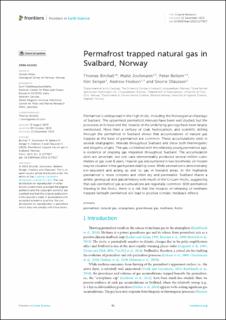Permafrost trapped natural gas in Svalbard, Norway
Birchall, Thomas; Jochmann, Malte Michel; Betlem, Peter; Senger, Kim; Hodson, Andrew; Olaussen, Snorre
Peer reviewed, Journal article
Published version

View/
Date
2023Metadata
Show full item recordCollections
- Import fra CRIStin [3586]
- Institutt for miljø- og naturvitskap [528]
Abstract
Permafrost is widespread in the High Arctic, including the Norwegian archipelago of Svalbard. The uppermost permafrost intervals have been well studied, but the processes at its base and the impacts of the underlying geology have been largely overlooked. More than a century of coal, hydrocarbon, and scientific drilling through the permafrost in Svalbard shows that accumulations of natural gas trapped at the base of permafrost are common. These accumulations exist in several stratigraphic intervals throughout Svalbard and show both thermogenic and biogenic origins. The gas, combined with the relatively young permafrost age, is evidence of ongoing gas migration throughout Svalbard. The accumulation sizes are uncertain, but one case demonstrably produced several million cubic metres of gas over 8 years. Heavier gas encountered in two boreholes on Hopen may be situated in the gas hydrate stability zone. While permafrost is demonstrably ice-saturated and acting as seal to gas in lowland areas, in the highlands permafrost is more complex and often dry and permeable. Svalbard shares a similar geological and glacial history with much of the Circum-Arctic, suggesting that sub-permafrost gas accumulations are regionally common. With permafrost thawing in the Arctic, there is a risk that the impacts of releasing of methane trapped beneath permafrost will lead to positive climatic feedback effects.
